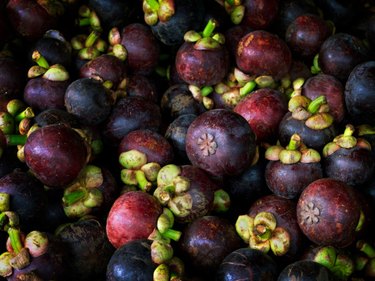
Native to the tropical rain forests of Malaysia, Indonesia and east Asia, the mangosteen tree (Garcinia mangostana) requires the warm temperatures of U.S. Department of Agriculture plant hardiness zones 11 through 12 to thrive. While you can sprout a mangosteen seed, it is a slow-growing, high-maintenance plant with specific environmental conditions. Though it may be challenging, growing a mangosteen in a container will add a lovely tropical ambience to your indoor garden.
Preparing for Planting
Video of the Day
The mangosteen is very slow-growing but generally doesn't respond well to transplanting. Use a biodegradable pot so when the tree is moved to a larger container, you can avoid disturbing the roots. Pulp pots are found as large as 16 inches wide and deep, making it easy to move up to the next size as the tree grows.
Video of the Day
Fill the flowerpot with a rich, well-drained potting mix suitable for tropical plants or citrus. Alternatively, mix your own by combining equal parts compost, coconut coir and lava rock or perlite. Wet the mix thoroughly before planting the mangosteen seeds.
Planting Mangosteen Seeds
Remove the seeds from fully ripe mangosteen fruits, which should have a reddish-purple rind and white to off-white flesh. Once removed from the fruit, the seeds must be planted within five days. Separate the seeds from the fruit and soak for 24 hours in room-temperature water. Plant the seeds 1 inch deep in the moist planting mix.
Keep the mix moist but not waterlogged until the seeds germinate in 18 to 43 days. Once the tree has sprouted, it may take two years to grow 12 to 18 inches tall. It has a long taproot; when moving to larger containers, select pots that are both deep and wide to accommodate the root system.
Caring for a Mangosteen Tree
Place the tree in a bright location where it receives full sun or filtered sunlight for six to eight hours or more daily. A grow light suspended above the tree adds additional light.
Mangosteen trees need a consistently moist soil but cannot tolerate standing water. Water thoroughly when the soil is dry to a depth of 1 to 2 inches. Add a 2- to 3-inch layer of mulch over the soil, pulling it back 3 inches from the tree's trunk. In addition, mangosteens need high humidity; consider adding a cool steam vaporizer and grouping similar potted plants to increase humidity.
Fertilize every four months with a balanced 10-10-10 or 20-20-20 fertilizer until the tree is three years old; then, reduce to every six to 12 months. If you prefer organic methods, fertilize weekly or bimonthly with a cup of compost tea or alternate with fish emulsion. Always water after fertilizing.
Flowering and Fruiting
Even after successfully growing a mangosteen from seed, it requires eight to 20 years to produce the first fruit. There is no guarantee that the tree will ever flower and fruit in a container-grown indoor environment. When they do flower, the 1 1/2- to 2-inch-wide flowers may be yellow-red with a green exterior spotted with red or yellow-green with red edges.
In its natural habitat, the tree may reach 80 feet tall, though the average height in other locations is between 40 and 50 feet tall. When contained in a flowerpot, your tree may still reach 10 to 15 feet over a number of years.